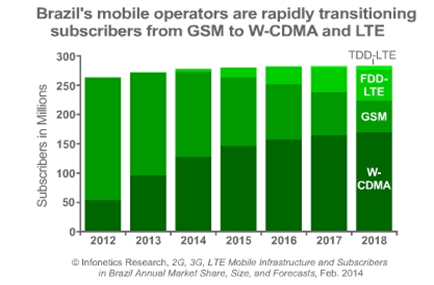 アナリストノート
Infoneticsでモバイル インフラおよび通信事業者経済を担当する主席アナリスト、Stéphane Téral氏は次のように指摘する。「国の大きさと強い経済力にもかかわらず、ブラジルのモバイル インフラストラクチャーの規模は控えめで、昨年初めの段階で基地局の総インストールベースがたったの6万局です。比較のために言えば、米国内にAT&T単独で大体同じ数の基地局を持っています。」
アナリストノート
Infoneticsでモバイル インフラおよび通信事業者経済を担当する主席アナリスト、Stéphane Téral氏は次のように指摘する。「国の大きさと強い経済力にもかかわらず、ブラジルのモバイル インフラストラクチャーの規模は控えめで、昨年初めの段階で基地局の総インストールベースがたったの6万局です。比較のために言えば、米国内にAT&T単独で大体同じ数の基地局を持っています。」Téral氏はこうつけ加える。「もちろんブラジルは現在進行中の反ワールドカップ暴動やその他のインフラ事情への対処のためにさらに大きな問題を抱えていますが、FIFAワールドカップまであと4ヶ月間でどのようにモバイル対応することが可能なのか私にはわかりません。ブラジルではいくつかのスタジアムで分散アンテナシステム (DAS) を導入しているので、スタジアムは問題ないはずですが、リオのマラカナスタジアム周辺のように、押しかける群衆のモバイル トラフィックを処理する基地局の数がスタジアム周辺地域であまりに少なすぎます。そして今のところ、2016年にオリンピックの大部分が開催されるジャカレパグアには基地局がたったの24局しかありません。ブラジルにはやるべきことがまだあるのです。」 ブラジル モバイル インフラ市場のハイライト
- モバイル普及率136%、加入者2.76億人でありながら、負荷に対応するには不十分な基地局 (BTS) しか持たないブラジルのモバイル通信速度は平均約1.4Mbpsと遅い。
- LTEではなく3Gが2013年のブラジルにおける主要な支出対象だった (2.78億ドル対9600万ドル)。
- Telefónica's Vivoがブラジルでトップのモバイル事業者であり、Telecom ItaliaのTIMをわずかにリードしている。
- ベンダー側では、NSNが市場シェアの3分の1超でブラジルRAN市場をリードしており、Ericssonがすぐ後ろに続き、あとはHuaweiで上位3位が占められている。
- Infoneticsの予想では、ブラジルのモバイル インフラ市場は2016年まで成長した後、主要なインフラ プロジェクトが完了し、暗い見通しになると見ている。結果として2013年から2018年の複合年間成長率 (CAGR) は0.4%となるだろう。
- 現在進行中のプリペイドから後払いへの移行は、ブラジルでの大きな変化である: 10年前にはブラジルの携帯電話加入者数の85%以上がプリペイドだったが、今日ではおよそ71%にまで低下している。
Is Brazil mobile-ready for FIFA World Cup? Infonetics report says NO! [[[Campbell, CALIFORNIA, February 28, 2014-Market research firm ]]] Infonetics Research released excerpts from its new 2G, 3G, LTE Mobile Infrastructure and Subscribers in Brazil market share and forecast report, which tracks GSM, W-CDMA, and LTE equipment and subscribers in Brazil. ANALYST NOTE "Despite the size of the country and its economic clout, Brazil's mobile infrastructure is modest in size, with a total installed base of just 60,000 base transceiver stations at the beginning of last year. For comparison's sake, AT&T alone has roughly this many BTS in the U.S.," notes Stéphane Téral, Infonetics' principal analyst for mobile infrastructure and carrier economics.
"Brazil has even bigger problems to address, of course, with ongoing anti-World Cup riots and other infrastructure issues, but I don't see how they will possibly be mobile-ready in 4 months for the FIFA World Cup," adds Téral. "They've installed distributed antenna systems (DAS) in some stadiums, so those should be fine, but there are way too few base transceiver stations in surrounding neighborhoods, such as those around the Maracanã stadium in Rio, to handle the mobile traffic of the impending crowds. And currently there are only 24 base transceiver stations in Jacarepaguã, where most of the Olympics will be hosted in 2016. Brazil has some work to do." BRAZIL MOBILE INFRASTRUCTURE MARKET HIGHLIGHTS
- With 136% mobile penetration - 276 million subscribers - and not enough base transceiver stations (BTS) to accommodate the load, mobile communications in Brazil are slow, around 1.4 Mbps on average
- 3G, not LTE, was the major spending event in Brazil in 2013 ($278 million vs. $96 million)
- Telefónica's Vivo is Brazil's top mobile operator, slightly ahead of Telecom Italia's TIM
- On the vendor side, NSN leads the Brazilian RAN market with over a 1/3 market share; Ericsson is a close 2nd, with Huawei rounding out the top 3
- Infonetics expects Brazil's mobile infrastructure market to grow through 2016 and then turn bleak as major infrastructure projects are completed, resulting in a 2013-2018 CAGR of 0.4%
- The ongoing shift from prepaid to postpaid is Brazil's major transformation: A decade ago, over 85% of Brazil's mobile subscriber base was prepaid, falling to around 71% today

